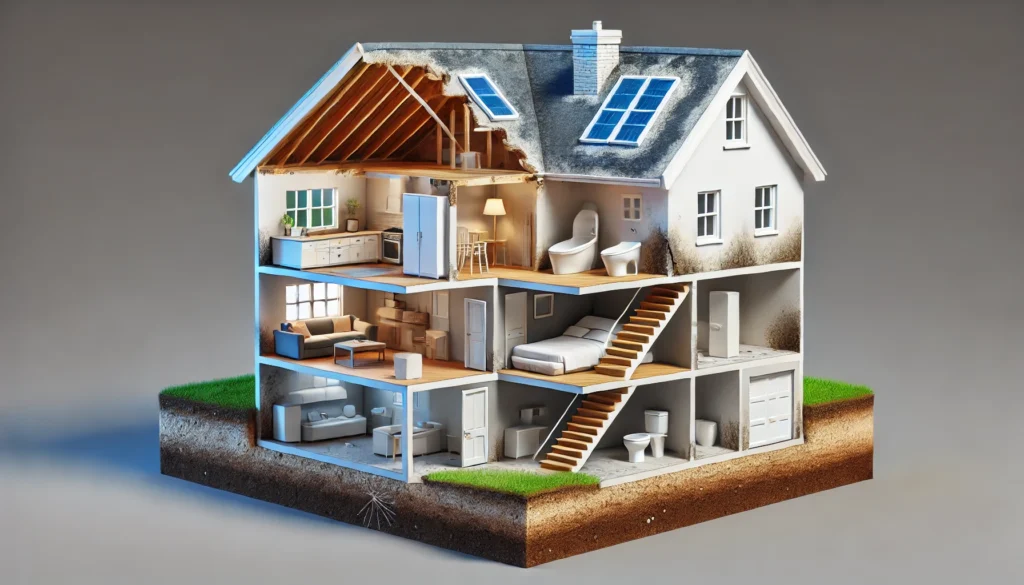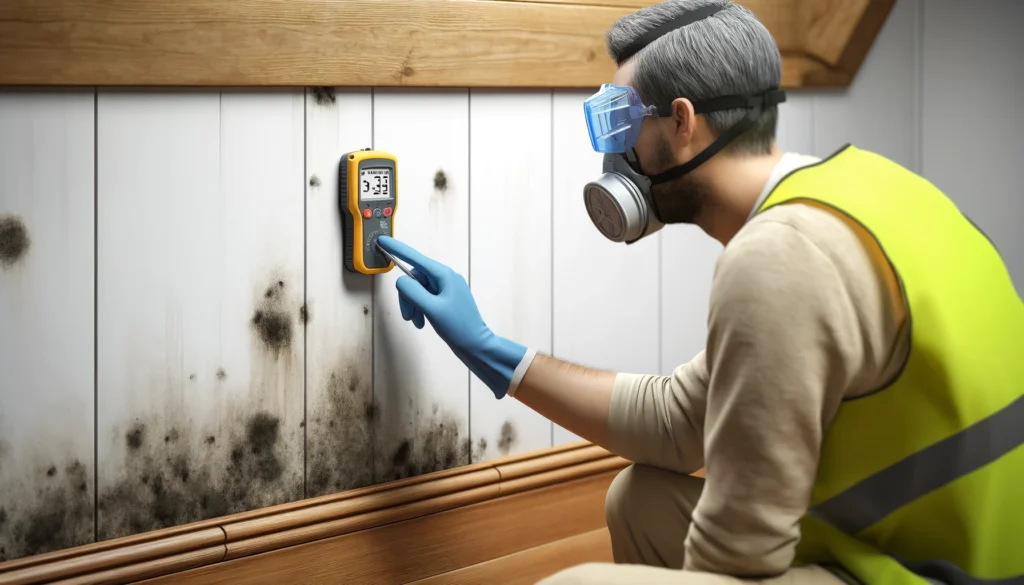Mold is an issue that can wreak havoc on your home and health if left unchecked. Whether you’re dealing with minor mold problems or a full-blown infestation, a proper mold inspection can save you from costly repairs and health hazards. In this guide, we’ll dive deep into what mold inspection entails, how the process works, and the steps involved in mold remediation. By the end, you’ll have a better understanding of how to keep your home safe from mold damage.
What Is a Mold Inspection?
A mold inspection is a thorough evaluation of your property to determine the presence of mold. Mold can grow in damp, warm environments, which makes homes a perfect breeding ground. The inspection process not only checks for visible signs of mold but also investigates hidden areas that might be prone to moisture buildup. The goal is to identify mold problems early before they become severe.
Mold inspections are essential for homeowners and business owners, especially those who suspect mold growth or are purchasing a property. Left untreated, mold can cause significant damage to the structure and pose health risks, such as respiratory issues, allergies, and even infections.
The Importance of a Mold Inspection
Mold is not always visible. It can lurk behind walls, under flooring, and in HVAC systems. Conducting a mold inspection is crucial because:
- Health Concerns: Mold can produce allergens, irritants, and, in some cases, toxic substances. People exposed to mold can suffer from various symptoms, including nasal stuffiness, throat irritation, coughing, wheezing, eye irritation, or skin irritation.
- Structural Damage: Mold thrives on moisture, and when it grows on wood, drywall, or insulation, it can weaken the structural integrity of your home. This can lead to costly repairs if not addressed in time.
- Real Estate Transactions: If you’re buying or selling a home, a mold inspection is a must to ensure the property is mold-free and in good condition. Many potential buyers won’t close the deal if mold is found on the property.
How Do You Inspect for Mold?
Mold inspections involve a combination of visual assessments and mold testing. A certified mold inspector will typically follow these steps during the inspection:
1. Visual Examination
This is the first step in the inspection process, where the inspector looks for visible signs of mold, such as discoloration on walls, ceilings, or floors, and musty odors. They also check for areas prone to moisture buildup, such as bathrooms, basements, kitchens, and attics.
2. Moisture Detection
Mold growth is directly related to moisture, so identifying moisture sources is critical. Inspectors use tools like moisture meters and infrared cameras to detect moisture behind walls or under floors. They might also check for water leaks or inadequate ventilation that could be contributing to the mold problem.
3. Air Sampling
Air sampling is used to determine the concentration of mold spores in the air. This is important because even if mold isn’t visible, spores could still be present and posing a health risk. The samples collected are analyzed in a lab to identify the type and concentration of mold spores present in your home.
4. Surface Sampling
Surface samples are taken to check if mold is present on surfaces like walls, floors, or HVAC systems. This helps to confirm if the discolored area is indeed mold. Surface samples are collected with swabs or tape and sent to a lab for testing.
What Are the Two Types of Mold Inspections?
There are generally two types of mold inspections:
- Visual Mold Inspection: This involves a thorough look at the property, focusing on areas where mold is likely to grow. The inspector searches for water damage, discoloration, and musty odors that indicate mold presence. They may use moisture meters to pinpoint areas of concern.
- Mold Testing Inspection: This type of inspection involves collecting samples of the air or surfaces. Mold testing inspections are crucial for determining the type of mold present and understanding the scope of the problem. A lab will analyze these samples to give an accurate report of mold concentration levels and species.
How Can You Test for Mold in Your House?
While professional mold inspectors can provide a comprehensive inspection, there are several ways you can test for mold in your house. Here are the common methods:
1. DIY Mold Test Kits
Homeowners can buy mold testing kits, which typically include collection tools and instructions for testing surfaces or air samples. Once collected, you send the samples to a lab for analysis. However, DIY kits aren’t as reliable as professional testing.
2. Professional Mold Testing
A certified mold inspector uses advanced equipment to conduct air sampling and surface sampling, which is far more reliable than DIY kits. Air samples are taken using specialized equipment that traps airborne mold spores. These samples are then sent to a lab to determine the mold species and concentration.
3. HVAC Inspection
Mold can often grow in your HVAC system, especially in air ducts where moisture accumulates. A mold inspection will often include checking your HVAC system to ensure it’s free of mold contamination. Mold spores circulated through your home’s ventilation can worsen health problems for occupants.
What Tests Are Done to Identify Mold?
Several tests can be performed to identify mold in your home. The main tests include:
- Air Sampling: This test measures the level of mold spores in the air, providing an accurate assessment of indoor air quality.
- Surface Sampling: Used to determine if mold is growing on visible surfaces. This can help confirm suspicions of mold growth.
- Bulk Sampling: This involves collecting pieces of material, such as drywall or insulation, where mold is suspected. These materials are then sent to a lab to check for mold colonies.
- ERMI Test (Environmental Relative Moldiness Index): This advanced test collects dust from surfaces and compares mold levels to a national database to determine mold contamination levels.

Mold Remediation: The Solution After Inspection
Once a mold inspection confirms the presence of mold, the next step is remediation. Mold remediation involves cleaning up existing mold and preventing future mold growth. Here’s a breakdown of the process:
1. Containing the Mold
To prevent mold spores from spreading to other parts of the home, the affected area is sealed off. This is typically done with plastic sheeting and negative air pressure to keep spores from escaping.
2. Removing Mold-Infested Materials
If mold has penetrated building materials like drywall or insulation, these materials need to be removed. Professionals will carefully dispose of these contaminated items to prevent further spreading.
3. Cleaning and Disinfecting
All surfaces that came into contact with mold will be thoroughly cleaned with specialized cleaning agents. This may include scrubbing, wiping, or using HEPA vacuums to capture mold spores.
4. Drying the Area
Moisture is mold’s best friend, so the next step is to dry the affected area thoroughly. This often involves using dehumidifiers and fans to remove moisture and prevent further mold growth.
5. Preventive Measures
To prevent future mold growth, mold remediation professionals may recommend improving ventilation, fixing water leaks, and using moisture barriers. Applying antimicrobial treatments to surfaces can also prevent mold from returning.
Conclusion
Mold inspections are essential for identifying mold problems early and protecting both your home and your health. While mold can pose significant risks, timely inspections and proper remediation can ensure that your living space remains safe and mold-free. Whether you’re a homeowner, business owner, or prospective buyer, investing in a mold inspection will save you from headaches and financial strain down the line.
FAQs
What is the meaning of mold inspection?
Mold inspection is a process where a certified professional examines a property to detect mold growth. The inspection usually involves visual checks, air sampling, and moisture detection to uncover hidden mold.
How do you inspect for mold?
Inspecting for mold includes checking visible areas for signs of mold, using moisture meters to detect dampness, and collecting air and surface samples to determine the presence and type of mold.
How can you test for mold in your house?
You can test for mold using DIY mold test kits, though professional mold inspections that include air and surface sampling are more accurate.
What are the two types of mold inspections?
The two types of mold inspections are visual mold inspections and mold testing inspections, which involve collecting samples to confirm mold presence.
How important is a mold inspection?
Mold inspections are vital for maintaining a healthy living environment, preventing structural damage, and identifying hidden mold issues before they become severe.
What tests are done to identify mold?
Common tests include air sampling, surface sampling, and bulk sampling. These tests help identify mold concentration levels and the type of mold present.


